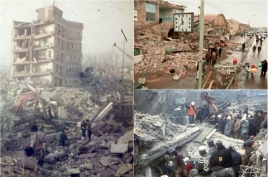1988 Armenian earthquake
Tuesday, June 21, 2022
The 1988 Armenian earthquake, also known as the Spitak earthquake, occurred on December 7 at 11:41 local time with a surface wave magnitude of 6.8 and a maximum MSK intensity of X (Devastating).
The shock occurred in the northern region of Armenia (then part of the Soviet Union) which is vulnerable to large and destructive earthquakes and is part of a larger active seismic belt that stretches from the Alps to the Himalayas. Activity in the area is associated with tectonic plate boundary interaction and the source of the event was slip on a thrust fault just to the north of Spitak. The complex incident ruptured multiple faults, with a strike-slip event occurring shortly after the initiation of the mainshock. Between 25,000 and 50,000 were killed and up to 130,000 were injured.
Seismologists thoroughly studied the effects of the Spitak event, including the mainshock and aftershock fault rupture mechanisms, and were on site setting up temporary seismometers before the end of 1988. Earthquake engineering experts scrutinized building construction styles and found fault in the poorly constructed apartments and other buildings that were built during the Era of Stagnation under the rule of Leonid Brezhnev. The cities of Spitak, Leninakan (Gyumri) and Kirovakan (Vanadzor) were greatly affected with large losses of life and devastating effects to buildings and other structures. A number of the smaller outlying villages away from the larger population centers were also severely affected.
Despite the tensions of the Cold War, Soviet leader Mikhail Gorbachev formally asked the United States for humanitarian help within a few days of the earthquake, the first such request since the late 1940s. One hundred and thirteen countries sent substantial amounts of humanitarian aid to the Soviet Union in the form of rescue equipment, search teams and medical supplies. Private donations and assistance from non-governmental organizations also had a large part of the international effort. While transporting some of these supplies to the region, a Soviet aircraft carrying 9 crew members and 69 military personnel, and a transport plane from Yugoslavia, were both destroyed in separate incidents. In support of the relief effort, recording artists united to produce several music-related contributions for the victims of the quake. A song was produced by a duo of French composers (including Charles Aznavour) and a studio album that featured songs donated by mainstream rock bands was released from the Rock Aid Armenia effort by the British music industry.
Political background
Beginning with late 1987 the Caucasus region was experiencing a surge in political turmoil with large and near constant demonstrations being held in the capital of Yerevan beginning in February 1988. For the fifteen months prior to the earthquake and at times up to hundreds of thousands of protesters, represented by the Karabakh Committee, were demanding both democracy and the unification of Nagorno-Karabakh (administered by Soviet Azerbaijan but disputed autonomous territory with a 76% Armenian majority and a 23% Azerbaijani minority in 1989) in the mountains of the Karabakh region. The unrest and the opposition movement began in September 1988 with negotiations between the Karabakh Committee and Gorbachev taking place throughout most of 1989. The relationship between the Soviet authorities and the Armenian society took a turn for the worse in March and the developments climaxed in November when a state of emergency was declared, along with a nighttime curfew, and a mass movement of up to 50,000 Armenians fleeing ethnic violence arrived from Azerbaijan.





